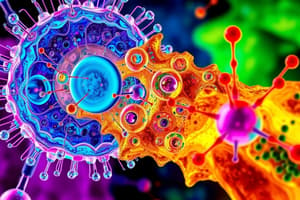Podcast
Questions and Answers
What is the energy required to remove an electron from an atom or molecule?
What is the energy required to remove an electron from an atom or molecule?
- Sample thickness
- Ionization potential (correct)
- Electron beam energy
- Electron scattering
What is the primary effect of excessive ionization on the sample in electron microscopy?
What is the primary effect of excessive ionization on the sample in electron microscopy?
- Formation of radicals
- Changes in the sample's chemistry
- Sample damage (correct)
- All of the above
Which of the following factors does NOT affect ionization potential in electron microscopy?
Which of the following factors does NOT affect ionization potential in electron microscopy?
- Microscope lens quality (correct)
- Sample composition
- Sample thickness
- Electron beam energy
What technique is used to reduce thermal motion and minimize ionization in electron microscopy?
What technique is used to reduce thermal motion and minimize ionization in electron microscopy?
Which of the following elements has a higher ionization potential?
Which of the following elements has a higher ionization potential?
What is the primary interaction between the electron beam and the sample in electron microscopy?
What is the primary interaction between the electron beam and the sample in electron microscopy?
Why is understanding ionization potential crucial in electron microscopy?
Why is understanding ionization potential crucial in electron microscopy?
Which technique is used to reduce the sample's susceptibility to ionization in electron microscopy?
Which technique is used to reduce the sample's susceptibility to ionization in electron microscopy?
Flashcards are hidden until you start studying
Study Notes
Ionization Potential in Electron Microscopy
Definition
- Ionization potential: the energy required to remove an electron from an atom or molecule
- In electron microscopy, ionization potential is important for understanding the interaction between the electron beam and the sample
Effects on Electron-Specimen Interactions
- Electron scattering: electrons in the beam interact with the sample, causing scattering and absorption
- Ionization: high-energy electrons can ionize atoms in the sample, leading to the formation of radicals and changes in the sample's chemistry
- Sample damage: excessive ionization can damage the sample, affecting its structure and composition
Factors Affecting Ionization Potential
- Electron beam energy: higher energies increase the likelihood of ionization
- Sample composition: elements with lower ionization potentials (e.g., C, N, O) are more susceptible to ionization than those with higher ionization potentials (e.g., Au, Pt)
- Sample thickness: thicker samples are more prone to ionization and damage
Techniques to Minimize Ionization Potential Effects
- Low-voltage electron microscopy: using lower beam energies to reduce ionization and sample damage
- Cryo-electron microscopy: cooling the sample to reduce thermal motion and minimize ionization
- Sample preparation: using techniques like staining or coating to reduce the sample's susceptibility to ionization
Importance in Electron Microscopy
- Understanding ionization potential is crucial for optimizing imaging conditions and minimizing sample damage
- Ionization potential affects the interpretation of electron microscopy data, as it can influence the observed structure and composition of the sample
Ionization Potential in Electron Microscopy
Definition
- Ionization potential is the energy required to remove an electron from an atom or molecule.
- Ionization potential plays a crucial role in electron microscopy, as it affects the interaction between the electron beam and the sample.
Effects on Electron-Specimen Interactions
- Electron scattering occurs when electrons in the beam interact with the sample, resulting in scattering and absorption.
- Ionization of atoms in the sample leads to the formation of radicals and changes in the sample's chemistry.
- Excessive ionization can cause sample damage, affecting its structure and composition.
Factors Affecting Ionization Potential
- Higher electron beam energies increase the likelihood of ionization.
- Elements with lower ionization potentials (e.g., C, N, O) are more susceptible to ionization than those with higher ionization potentials (e.g., Au, Pt).
- Thicker samples are more prone to ionization and damage.
Techniques to Minimize Ionization Potential Effects
- Low-voltage electron microscopy reduces ionization and sample damage by using lower beam energies.
- Cryo-electron microscopy minimizes ionization by cooling the sample to reduce thermal motion.
- Sample preparation techniques, such as staining or coating, can reduce the sample's susceptibility to ionization.
Importance in Electron Microscopy
- Understanding ionization potential is crucial for optimizing imaging conditions and minimizing sample damage.
- Ionization potential affects the interpretation of electron microscopy data, as it can influence the observed structure and composition of the sample.
Studying That Suits You
Use AI to generate personalized quizzes and flashcards to suit your learning preferences.




